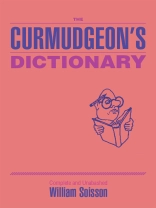Twenty years ago, when the author first read Ambrose Bierce’s ‘Devil’s Dictionary, ‘ he was ecstatic. Here at last was a creative work that was utterly lacking in discrimination. Worth no regard whatever for race, creed, color, sex, religion, or fast food preference, Bierce kicked everyone’s sacred cow right in the udder. The author instantly knew that somehow, some day, he must continue the work begun by Ambrose. So it is that ‘The Curmudgeon’s Dictionary’ follows the great Bierce’s lead in flaying without mercy the pretentious of our world.
At the same time, ‘TCD’ unavoidably reflects many of the changes in style that have occurred in our language since 1911, when ‘The Devil’s Dictionary’ was first published. Many of the old poets, like Biddle Tamey and Opned Teal, so well quoted by Bierce, are gone, having been replaced by such contemporary greats as Taner Bane and Sigson Kolgy, who, though they lack the elegance of the poets of Bierce’s day, have the virtues of simplicity and forthrightness.
Then, too, changes in science and technology have brought us many new terms such as ‘computer, ‘ ‘CAT Scan, ‘ ‘Jive, ‘ and ‘Monica, ‘ which did not yet exist in Bierce’s day. Moreover, changes in the attention span have made it desirable to abbreviate many definitions and support the work of the aforementioned more concise poets. The author has violated this procedure only when considerations of clarity or beauty have made it imperative, as with the haunting ‘Ode to a Giant Bonsai Tree.’
Aside from such evolutionary matters, one will find that some of the venerable Bierce’s definitions are still valid today and have found their way into this magnificent book in updated form. The updating is no criticism of the master, only recognition that time moves things, if not forward, at least along.
Sobre el autor
Bill Soisson has always loved words. In first grade, his teacher noticed that he had an unusually large working vocabulary. She gave him increasingly difficult tests in order to explore his talent. It wasn’t until he was examined at the eighth-grade level that little Soisson missed a single vocabulary answer. The word was ‘Sumperfla’d’. No correct synonym was provided among the possible answers.
Did this spiteful and envious act of a primary school teacher cause our young hero to cry foul? Not at all. It merely caused him to embark on a lifelong search for the meaning of the word ‘sumperflad, ‘ and it was during his search that Soisson, after intensely studying Ambrose Bierce’s ‘Devil’s Dictionary, ‘ came up with the idea of “The Curmudgeon’s Dictionary’ as a way of raising the money he needs to continue his quest. It also allows him to get a perverted sort of revenge on that now-Attzheimerish teacher by playing his own dirty tricks with words.
As he matured, a philosophy degree at the University of Notre Dame and a law degree at Dickinson provided young Soisson first with insight and then chicanery regarding the use of words. The years he spent in Europe and Africa, using other languages, served to teach him to make a mess out of his own tongue. The discipline of writing for publication in such fields as international law and the Islamic and Bantu cultures taught him the use of words as “flatulence.” And along the way, he became an accomplished speaker before audiences of all sizes.
When an interviewer asked whether he was comfortable speaking to large groups, Soisson responded, ‘Yes. It’s the listeners who are uncomfortable.’
As for the future of his work, the scholarly Soisson says, ‘My aim is ultimately to destroy everyone’s pomposities, deceptions, and absurdities until I am the only person left with pomposities, deceptions, and absurdities.’












